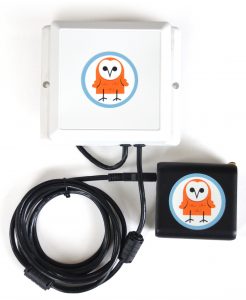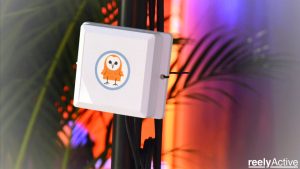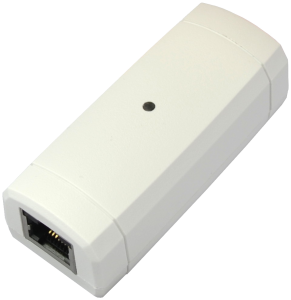
reelyActive: Where the web meets the physical world
Stephen Law
Automation / Robotics Electronics Engineering Software Wireless Engineering IoT Internet of Things Internet of Things IoT IoT reelyActive reelyActiveMontreal start-up’s technology enables computers to observe in real-time who/what is where/how
The Internet of Things (IoT), already a movement in the technology industry, is finding innovative ways of connecting the physical and digital worlds to provide humans with an easier user interface for real life. Montreal-based reelyActive has innovatively captured and commercialized the essence of IoT with its technology platform, which establishes a digital understanding of physical spaces and the dynamics of the people and assets within. A continuous source of data for continuous improvement.

reelyActive’s founding innovation (and namesake) is a novel daisy-chain architecture that facilitates coverage and provides flexible granularity.
According to reelyActive CEO Jeff Dungen his platform delivers a real-time stream of location and context data with which businesses can continuously improve their operations, maximizing both efficiency and the human experience. The technology employed by reelyActive enables computers to observe in real-time who/what is where/how, in any physical space, and in a language that they understand.
Founded two years ago, reelyActive’s IoT solution connects the physical and digital worlds using ‘reelceivers’, or little keychain-sized location devices. Physical locations who set up these reelceivers can display on screens who’s present and how they’re interacting, using social media like Twitter and LinkedIn. Brick and Mortar locations can implement them to study the behaviour of their shoppers. The reel can simultaneously support protocols such as Bluetooth Low Energy, supported by the latest smartphones, wearables, and tracking device.
Recently recognized as a start-up leader among its global peers, EP&T sits down with reelActive CEO Jeff Dungen to have him explain the technology he and his team developed.
Q. How would you define your technology company?
You could say that reelyActive is what you might expect if a tech startup and tech activists had a baby. Our team have strong philosophical and ethical views about the future and are working together to develop the technology that advances our vision and mission. I’m quite proud of the fact that we’ve been able to maintain this balance over the past eight years. It’s certainly one of our defining characteristics as a company.

reelyActive’s hardware acts as the nervous system of a physical space providing a real-time stream of data to ope source software, which can run edge, on-prem or Cloud.
Q. Describe your educational background as a computer engineering graduate from University of Waterloo and how it may have contributed to the creation of reelyActive.
Yes, I studied computer engineering at UW during the rise and pop of the dot-com bubble which offered much wisdom about the realities of tech startups, especially timing and resilience. Computer engineering covered both hardware and software which provided a solid foundation for the creation of reelyActive which innovates in both of these fields. And 4-month co-op work terms certainly taught me to learn fast and get a lot done in a short time which is definitely an asset in any startup.
Q. Industry is at the gateway of widespread IoT adoption. How will your technology minimize existing challenges for those navigating the digital transformation?
Industry will definitely drive widespread IoT adoption with the current trend of digital transformation. Ideally, the IoT component of this transformation will combine the in-house expertise of the business with standard commercial platforms and products. We’ve developed our technology to observe the leading standards (avoiding lock-in and obsolescence) and to facilitate adoption by subject matter experts (rather than IoT technology experts). In other words, any business can comfortably and cost-effectively advance on initiatives with our platform alone, adding external expertise and third-party platforms when and where necessary.

reelyActive’s plug-and-play simplicity facilitates coverage where and when it is needed.
Q. Describe how reelyActive’s open-source software is unique to the existing competitive landscape what will be its greatest impact?
Open source software will be key to widespread IoT adoption, the motivation for our vision. And, from a business standpoint, the benefits of open source are significant, if often misunderstood. For instance, the software must continuously evolve to keep pace with the proliferation of IoT devices and platforms. Open source software has the advantage of accepting contributions from third-party vendors, clients and passionate volunteers to remain on the cutting edge. Although proprietary software products represent a very competitive offering today, over time I think they will lose their edge to actively maintained open source alternatives.
Q. Outline the role your radio hardware plays, as a plug-and-play unit that identifies and locates wireless devices in a controlled environment.
Our hardware acts as the nervous system of a physical space, providing a real-time stream of data to the open source software which can run edge, on-prem or cloud. The hardware serves as infrastructure for wireless devices to be identified, located and to share their sensor data. We initially developed a novel daisy-chain hardware architecture that is well suited to permanent deployments. Based on market interest we later developed our Owl-in-One gateway which supports WiFi connectivity and USB power, facilitating short-term and portable deployments. That’s our best-seller today and a successor is in the works.
Q. Are there any limitations to the types of electronic devices that can be located or accommodated within the reelyActive system?
Our hardware is compatible with active RFID devices which spontaneously transmit to any devices in range. Bluetooth Low Energy has been a game changer in this respect with over a billion devices per year shipping since about 2014. This allows physical spaces to anonymously detect their occupants via the devices (smartphones, wearables) that those occupants already carry. Our software is compatible with any radio-transmitting devices, including passive RFID, of which there are tens of billions of tags shipping annually. Our open source software can of course be integrated with third-party readers and gateways.
Q. The Internet of Things continues to take significant strides in global adoption – connecting the physical and digital worlds. Where do you anticipate the most ambitious use of reelyActive technologies – i.e. commercial, consumer level, B2B usage?
The most ambitious use of our tech will be to usher in an era of digital avatars with the ability to interact with one another and their physical surroundings. Back in 2012 we set up a live directory display in the FounderFuel accelerator. By carrying a keyfob, participants would have their profile displayed as soon as they walked in the front door. They loved the visibility this provided them and their startups/projects. There is no technical barrier to a widespread adoption of such applications (with opt-in of course).
reelyActive’s design team has generally been comprised of an embedded software expert and hardware prototyping expert with strong background in RF.
Q. Given the increased concerns regarding cybersecurity issues, how does your firm allay users fears with your systems/platforms or potential misuse of data?
We don’t store data. It’s as simple as that! Our technology provides a real-time stream of data which our users are free to handle, secure and store in accordance with their needs. Moreover, the Bluetooth Low Energy devices that our hardware detects are free to cycle their identifiers periodically to maintain anonymity. Smartphones take advantage of this in the interest of their users.
Q. Describe the development of reelyActive’s industrial-grade transceiver infrastructure (hardware)? As well, describe the make-up of your design team.
The three reelyActive co-founders gained a lot of experience working together at a previous real-time location startup in the 2000s, and noted that many deployments were in harsh environments with limited access to power and wireless networking. The “reel”, our wired daisy-chain architecture of industrial-grade transceivers, was developed to address these challenges. Our design team has generally been comprised of an embedded software expert and a hardware prototyping expert, both with a strong background in RF.
Q. Summarize the journey your firm has taken thus far – versus prior to launch eight years ago.
We launched reelyActive in 2012 to meet a specific need of a single client. We knew already then that what we were developing could become a broadly-applicable platform, but it was only once we participated in a startup accelerator that we gave precedence to this big vision. It hasn’t been an easy journey. Being ahead of the market, having to develop our own hardware, and choosing the open source model have all been challenging. But, having selected that path, now that the market is maturing, we find ourselves in a unique and enviable position.
Q. You describe reelyActive’s vision as ubiquitous machine-contextual-awareness at the ‘service of humanity’. Expand upon that if you can.
Think of ubiquitous machine-contextual-awareness as computers being able to sense and understand the physical world in which we live, work and play. For many, that’s a scary proposition given their exposure to science-fiction, state-run surveillance and/or the questionable ethics and motivations of tech companies. That’s why, for us, it is paramount not only to specify that such technology must be at the service of humanity, but to act consistently and decisively towards that outcome.

reelyActive CEO Jeff Dungen.
Q. Recognized among the top tech start-ups in Canada, what advice would you give to those who are starting down the path of tech creation?
Be resourceful and take advantage of the many programs available to early-stage technology companies. Get a product in market as soon as possible: paying clients provide the best feedback to guide your business and product development. Be tenacious to get across the funding gaps you can expect to encounter. Don’t be a humble Canadian when pitching and selling your product – communicate your value proposition and successes loud and clear to the broadest audience. If you’re successful, invest your time and winnings back into local tech startups. If you fail, embrace it and invest your experience back into the tech startup community. And don’t forget to look out for your peers and to take care of your own mental, physical and financial health. It’s a marathon (or rather a series thereof), not a sprint!
